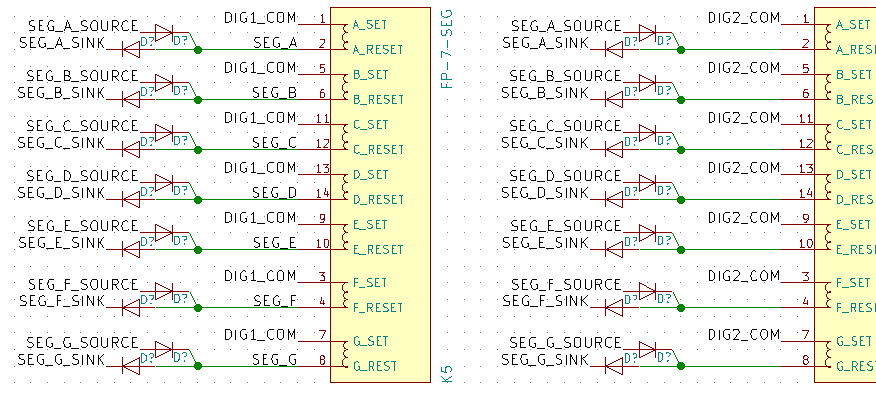After feeling that the first driver design using half bridges wasn't an ideal solution, I've had a go a reworking the segment drivers to use a multiplexed H-bridge configuration:

This is similar to the design that Coyt Barringer used in his clock using these displays, though I've saved one GPIO per digit by having the digits alway connected to 16V or GND at the expense of a slightly more complex driving sequence.
Turns out, this design has its own downsides though... mainly the sheer number of discrete components involved.
The half-bridge driver design needed 86 components for the driver and digit select:
- 70 components for segment drivers (10 for each of the 7 segments)
- 10 components for digit select (2 per digit)
- 6 components for the split rail supply
A multiplexed H-bridge on the other hand requires 156 discrete components:
- 56 components for segment source/sinks (8 for each of the 7 segments)
- 30 components for each digit source/sink (6 per digit)
- 70 diodes to prevent unwanted current flow: 2 per segment, per digit.

Cost is a factor
Doubling the component count is a bit eye-watering when thinking about layout and manual assembly, but let's see what the costs are like, ignoring shared components, resistors and capacitors (since they cost about the same in each design).
Split rail push/pull
| Part | Quantity | Per unit | Subtotal (NZD) |
|---|---|---|---|
| 30V 500mA NPN BJT (MMBT2222ALT1G) | 14 | $0.05 | $0.70 |
| -60V 500mA PNP BJT (MMBT2907ALT3G) | 7 | $0.05 | $0.35 |
| 30V 1/2W Zener diode (D3Z30BF-7) | 14 | $0.206 | $2.88 |
| Solid-State Relay (AQY282S PhotoMOS) | 5 | $2.30 | $11.50 |
| 40V 1A Op Amp (TCA0372BDP1G) | 1 | $1.17 | $1.17 |
| Total | $16.60 |
Multiplexed H-Bridge
| Part | Quantity | Per unit | Subtotal (NZD) |
|---|---|---|---|
| >20V 500mA NPN MOSFET (NTR4003NT1G) | 12 | $0.265 | $3.18 |
| -20V >500mA PNP MOSFET (DMG2301L-7) | 12 | $0.316 | $3.79 |
| 18V 1/2W Zener diode (DDZ18BSF-7) | 14 | $0.206 | $2.88 |
| 1/2W Diode (BAS16J) | 70 | $0.085 | $5.95 |
| NPN BJT (MMBT3904) | 12 | $0.047 | $0.56 |
| Total | $16.36 |
...Well, that doesn't help the decision process much! Even though the H-Bridge design has more components, I'm going to continue with it for now. I'd rather have a greater number of generic components than locking the design into vendor specific parts.
 Stephen Holdaway
Stephen Holdaway
Discussions
Become a Hackaday.io Member
Create an account to leave a comment. Already have an account? Log In.